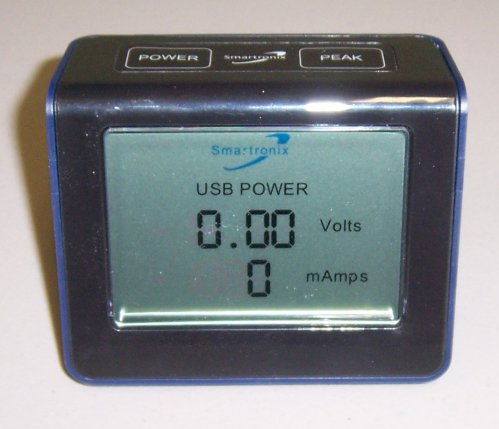
Most of the problems that turn up while configuring Raspberry Pi systems cook down to inadequate power. The infamous stuttering keyboard problem vanished immediately here when I put the RPi on a stiffer 5V supply. When I bought a second RPi for a programming system, I incorporated a powered hub capable of sourcing 500 ma from each port, and in doing so strangled the power problem in its crib.
Problem solved, but I still wondered: How much juice do these things actually need? How stiff is the 5V supply? I’m a bench tech, and not being able to do actual measurements made me nuts. So I sniffed around a bought a test instrument for measuring voltage and current at a USB port under load. It’s the Smartronix USB Power Monitor, model ST034TT05-01-001. I bought it from CyberGuys; $49.95.
It works like any current meter: You connect it between a USB port and a USB device. It simultaneously measures the voltage on the port and the current through the device. There’s a full-size Type A jack on the right side of the box for connecting the load, and a full-size AB cable plugging into a B jack on the left side of the box, which plugs into a Type A port.
Works like a charm. I did the measurements below in about ten minutes:
| Raspberry Pi board running Raspbian, w/o Wi-Fi | 50-73 ma |
| Dell 0C8639 wired USB mouse | 5-17 ma |
| Dell SK8135 wired USB keyboard | 53-56 ma |
| AirLink AWLL5088 Wireless N Ultra Mini USB Wi-Fi | 32-80 ma |
| SanDisk Cruzer Mini thumb drive, 256 MB | 27-30 ma |
| SanDisk Cruzer Micro Skin thumb drive, 256 MB | 75-89 ma |
| San Disk Cruzer Mini thumb drive, 512 MB | 7-11 ma |
| KingMax Super Stick thumb drive, 512 MB | 35-62 ma |
| SanDisk Cruzer Mini 1 GB thumb drive, 1 GB | 5-11 ma |
| SanDisk Cruzer Micro Skin thumb drive, 4 GB | 75-91 ma |
| SanDisk Cruzer Micro Skin thumb drive, 8 GB | 43-70 ma |
In the readings above, the two numbers are the range across which I saw current run. In most cases, the first number is when the device is idle, the second is when it’s busy. All measurements were taken from the same USB port, one of the four ports on the Rosewill powered hub. All devices tested are USB 2.0, because the meter itself is not listed as capable of testing USB 3 devices.
I have several of most of the thumb drives, and identical models were almost alike in their power behavior. This made me wonder how the Cruzer Minis managed to use so little power while doing the same task that all the other drives did. In this case, the task was copying a 109 MB file (the Lazarus 1.0.6 installer) from the PC to the thumb drive. One would think that smaller drives would draw less current, but not so.
Probably the biggest eyebrow-raiser was how rubbery the 5V USB rail is on my quadcore. An 8GB Cruzer Micro Skin thumb drive pulled the port down from 4.99 v to 4.91 v while drawing 90 ma. The same drive pulled the Rosewill hub supply down by only .02 v , from 5.17 v to 5.15 v while drawing 70 ma. (Current draw in thumb drives is not the same on the RPi as it is on Windows.)
My only gripe about the meter is that “peak” mode displays the highest values for voltage and current, when voltage and current generally move in opposite directions as load increases. So a downward movement in voltage isn’t registered in peak mode.
Other than that, it works as described and answered a whole lot of questions about what sorts of things I can reasonably expect to connect to a Raspberry Pi’s built-in USB ports. Actually, I now recommend using the powered hub for everything, given the RPi’s touchiness about power. It makes the RPi system bulkier and snakier, but a whale of a lot more reliable.
And as for the Smartronix USB power meter, let’s say solidly (if not quite highly) recommended.











From a brief review of the latest on Wikipedia about USB specs, I wonder whether some devices are bracing for a future in which the USB voltage is less certain than before? I see that for USB 1.0 and 2.0, the specified range was 4.75-5.25V, while on USB 3.0, the range has become 4.45-5.25 V. Also, for USB 3.0, a device is supposed to operate correctly down to 4V.
Putting all that together makes me wonder whether some devices may already incorporate a small CMOS buck-boost converter. If they do, that would help to explain the lower current drain of devices on the RPi, where the measured voltage is higher than on your quad-core.
A side-effect, of course, is that where the voltage coming in is low, the converter would require more current, and on a “rubbery” supply, that will make it sag further.